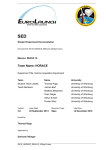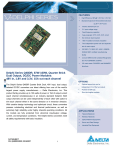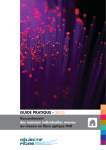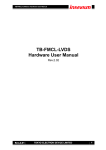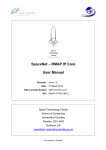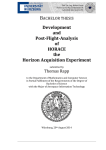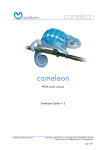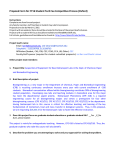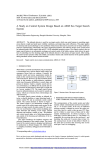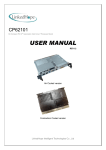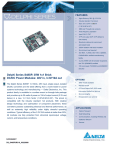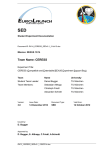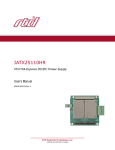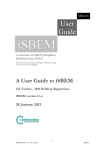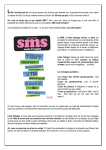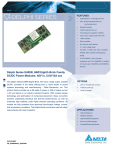Download Student Experiment Documention version 1.0
Transcript
SED Student Experiment Documentation Document ID: RX16_HORACE_SEDv1-0_28Jan13.docx Mission: REXUS 16 Team Name: HORACE Experiment Title: Horizon Acquisition Experiment Team Name University Student Team Leader: Thomas Rapp University of Würzburg Team Members: Jochen Barf University of Würzburg Sven Geiger University of Würzburg Arthur Scharf University of Würzburg Florian Wolz University of Würzburg Version: Issue Date: Document Type: Valid from: 1.0 28 January 2013 Spec 14 December 2010 Issued by: Thomas Rapp Approved by: Jochen Barf RX16_HORACE_SEDv1-0_28Jan13.docx Page 2 HORACE Student Experiment Documentation Change Record Version Date Changed chapters Remarks 0 1 2 3 4 5 2008-12-18 2013-01-28 New Version All Blank Book 2010 PDR CDR IPR Pre-Campaign Final report Abstract: Keywords: This paper contains the complete documentation of the HORACE-project which is payload on REXUS 16. The current version 1.0 represents the frozen status shortly before PDR. REXUS 16, SED - Student Experiment Documentation, HORACE, Horizon Acquisition Experiment, University of Würzburg, RX16_HORACE_SEDv1-0_28Jan13.docx Page 3 HORACE Student Experiment Documentation CONTENTS ABSTRACT ............................................................................................................. 6 1 INTRODUCTION ............................................................................................ 7 1.1 Scientific/Technical Background............................................................. 7 1.2 Mission Statement .................................................................................. 7 1.3 Experiment Objectives ........................................................................... 8 1.4 Experiment Concept ............................................................................... 8 1.5 Team Details .......................................................................................... 9 1.5.1 Contact Point ............................................................................. 9 1.5.2 Team Members ......................................................................... 9 2 EXPERIMENT REQUIREMENTS AND CONSTRAINTS ............................. 11 2.1 Functional Requirements ..................................................................... 11 2.2 Performance Requirements ................................................................. 12 2.3 Design Requirements ........................................................................... 14 2.4 Operational Requirements ................................................................... 15 2.5 Constraints ........................................................................................... 15 3 PROJECT PLANNING .................................................................................. 16 3.1 Work Breakdown Structure (WBS) ....................................................... 16 3.2 Schedule .............................................................................................. 18 3.3 Resources ............................................................................................ 19 3.3.1 Manpower ................................................................................ 19 3.3.2 Budget ..................................................................................... 20 3.3.3 External Support ...................................................................... 21 3.4 Outreach Approach .............................................................................. 21 3.4.1 Scientific News Services and University .................................. 21 3.4.2 Local Publicity.......................................................................... 22 3.4.3 Web Presence ......................................................................... 22 3.5 Risk Register ........................................................................................ 23 4 EXPERIMENT DESCRIPTION ..................................................................... 25 4.1 Experiment Setup ................................................................................. 25 4.2 Experiment Interfaces .......................................................................... 27 4.2.1 Mechanical .............................................................................. 27 4.2.2 Electrical .................................................................................. 27 4.3 Experiment Components ...................................................................... 29 4.4 Mechanical Design ............................................................................... 30 4.5 Electronics Design................................................................................ 32 RX16_HORACE_SEDv1-0_28Jan13.docx Page 4 HORACE Student Experiment Documentation 4.6 4.7 4.8 4.9 4.5.1 Camera .................................................................................... 32 4.5.2 Core System ............................................................................ 32 4.5.3 Clock........................................................................................ 33 4.5.4 Measurement Unit ................................................................... 33 4.5.5 Power Distribution Unit ............................................................ 33 Thermal Design .................................................................................... 33 Power System ...................................................................................... 34 Software Design ................................................................................... 34 4.8.1 Software Modes....................................................................... 34 4.8.2 Tasks ....................................................................................... 36 4.8.3 Data Handling .......................................................................... 39 4.8.4 Development ........................................................................... 42 Ground Support Equipment .................................................................. 42 4.9.1 EGSE....................................................................................... 42 4.9.2 MGSE ...................................................................................... 42 4.9.3 Ground Station ........................................................................ 42 5 EXPERIMENT VERIFICATION AND TESTING ........................................... 43 5.1 Verification Matrix ................................................................................. 43 5.2 Test Plan .............................................................................................. 47 5.3 Test Results ......................................................................................... 49 6 LAUNCH CAMPAIGN PREPARATION ........................................................ 50 6.1 Input for the Campaign / Flight Requirement Plans .............................. 50 6.1.1 Dimensions and mass ............................................................. 50 6.1.2 Safety risks .............................................................................. 50 6.1.3 Electrical interfaces ................................................................. 50 6.1.4 Launch Site Requirements ...................................................... 51 7 DATA ANALYSIS PLAN ............................................................................... 52 7.1 Data Analysis Plan ............................................................................... 52 8 ABBREVIATIONS AND REFERENCES ....................................................... 53 8.1 Abbreviations ....................................................................................... 53 8.2 References ........................................................................................... 55 8.3 List of Figures and Tables .................................................................... 55 APPENDIX A – EXPERIMENT REVIEWS ............................................................ 57 APPENDIX B – OUTREACH AND MEDIA COVERAGE ...................................... 58 APPENDIX C – ADDITIONAL TECHNICAL INFORMATION ................................ 64 RX16_HORACE_SEDv1-0_28Jan13.docx Page 5 HORACE Student Experiment Documentation RX16_HORACE_SEDv1-0_28Jan13.docx Page 6 HORACE Student Experiment Documentation ABSTRACT The aim of the Horizon Acquisition Experiment (HORACE) is to test and demonstrate the capabilities of a new approach for attitude determination, which also works under stress conditions like uncontrolled tumbling or spinning with high rates. Therefore the experiment processes optical data with image processing algorithms on an embedded system, so that the line of horizon is detected in the frames and a vector to the 2D projection of the center of the earth can be calculated. Unlike existing earth sensing systems using the IR spectrum to detect the earth, HORACE processes video frames of an ordinary camera, which is sensitive to the visible spectrum. Thus, there is strong emphasis on the software components of the system and we imagine a future system which could only be a software package capable enough to use data from existing payload-cameras for attitude determination in emergencies. During the experiment both video and calculated data are collected to provide qualitative and quantitative evidence about the robustness and accuracy of the horizon acquisition and the calculated earth vector, as well as for the general approach after post flight evaluation. The flight on REXUS provides a good setting for the experiment, because the launcher’s rotation is similar to uncontrolled tumbling or spinning movements and the reached altitude is high enough to take realistic, space-like images. HORACE has been initiated by five students of Aerospace Information Technology at University of Würzburg in close cooperation with and support of the Chair of Aerospace Information Technology in October 2012. It will be implemented throughout 2013 and launched in spring 2014 as payload of REXUS 16. The HORACE team (left to right): Jochen Barf, Sven Geiger, Arthur Scharf, Florian Wolz, Thomas Rapp RX16_HORACE_SEDv1-0_28Jan13.docx Page 7 HORACE Student Experiment Documentation 1 INTRODUCTION 1.1 Scientific/Technical Background As a further step in today’s way of technology towards completely autonomous satellites, a satellite’s attitude acquisition and control system (AACS) – an essential subsystem – must work autonomously not only during nominal phases of the mission but also in unexpected situations or emergency cases. These include situations during which the satellite’s main AACS is corrupt itself or during which the main AACS’s capability does not suffice, e.g. when the satellite is spinning and tumbling uncontrolled at high rates. To face those situations in the future we envision a sensor system which is autonomously able to (re)acquire a satellite’s attitude not only under nominal but also stress conditions mentioned above and which should also be affordable for smaller satellites and missions. In our opinion the best approach would be an horizon acquisition sensor system, as it – unlike many other attitude determination systems (e.g. sun sensors, star cameras etc.) – would work in more situations for following reasons: the central body’s (in most cases the earth’s) surface looks different to the dark space even during eclipse and it is only hardly probable – nearly impossible – that the satellite would spin and tumble in a mode during which the central body is never visible. In contrast to existing earth sensors, that detect the earth’s IR radiation, HORACE shall use an optical sensor, which is sensitive to the visible spectrum, for the horizon detection to keep expenses low and to emphasis the image processing software-components of the system. So that in a future version with more generic algorithms the system could possibly be only a software package, which is capable enough to use any camera data, e.g. images provided by existing payload-cameras. 1.2 Mission Statement HORACE on REXUS 16 is a technology demonstration mission for autonomous earth detection on satellites. The aim is to prove or disprove the general technical feasibility of the outlined approach. During the mission the functionality and robustness of the general approach is tested under realistic, space-like conditions, by means of the HORACESystem. After post flight evaluation it shall be determined whether the approach of autonomous horizon acquisition with a camera in conjunction with image processing algorithms running on an embedded system connected to the camera is indeed apt to (re)acquire a satellite’s attitude under nominal or stress conditions. RX16_HORACE_SEDv1-0_28Jan13.docx Page 8 HORACE Student Experiment Documentation 1.3 Experiment Objectives With the HORACE-System, whose development will be part of the mission, the following primary objectives shall be reached: Investigate whether horizon acquisition can be performed accurately enough for attitude determination. Determine whether the very dynamic and time-critical problem can be solved with an embedded system with a reasonable time resolution and power consumption. Secondary objectives are: 1.4 to show physical or systematic limits and problems of the general approach. to determine, if a future attitude determination system following the general approach would be applicable also for small satellites. Experiment Concept Figure 1-1: HORACE experiment concept The two key elements of HORACE are its camera and the core system. Furthermore, there is an independent measurement unit and a separate power distribution unit, which is the power interface to RXSM and provides regulated voltages to every component and of course the structure, which connects the experiment mechanically with the launcher. All components involved in data handling, namely the core system and measurement unit, are synchronized with a global time, so that results can be matched for post flight evaluation. RX16_HORACE_SEDv1-0_28Jan13.docx Page 9 HORACE Student Experiment Documentation The camera, which observes the outer environment of REXUS, passes its video data to the core system, which directly stores it to a mass storage and processes it for the horizon acquisition. The results of the calculation are also stored to mass memory. Additionally, the core system represents the data interface to RXSM and passes some of the results of its calculations to RXSM for downlink. The measurement unit regularly measures and saves health data, like currents and temperatures, autonomously and without any data interfaces to other subsystems or RXSM. The experiment starts working at lift off and works completely autonomously throughout the whole flight, so TC is not needed and thus not implemented. 1.5 Team Details 1.5.1 Contact Point The team’s contact person will be the Project Manager Thomas Rapp, whose contact information is as followed: Address: HORACE Team – Thomas Rapp c/o Prof. Dr. Hakan Kayal & Dipl.-Inf. Gerhard Fellinger (supervisors) Informatik VIII, Julius-Maximilians-Universität Würzburg Sanderring 2 97070 Würzburg GERMANY Phone: +49 1577/ 1529248 E-Mail: [email protected] 1.5.2 Team Members Thomas Rapp – Project Management Thomas is the student team leader and therefore responsible for the overall management of the HORACE project. He is in charge of the documentation as well as the project schedule and is the main contact person. He is also part of the mechanical workgroup and thus involved in the device assembly and mechanical design/integration of the experiment. Thomas is in his second undergraduate year of studies of Aerospace Information Technology at University of Würzburg. RX16_HORACE_SEDv1-0_28Jan13.docx Page 10 HORACE Student Experiment Documentation Jochen Barf – Algorithmic Development Jochen’s main task is to develop smart algorithms, which detect the horizon in the video frames and to calculate a 2D vector to the earth center, reliably and as fast as possible. He will also develop the required software components of the ground segment for TM/TC. Jochen is a student of Aerospace Information Technology at University of Würzburg in his second undergraduate year. Sven Geiger – Embedded System Development & Porting It’s Sven’s job to make sure that Jochen’s algorithms will run on the embedded system of the HORACE-System. He is also responsible for the rest of the embedded programming, which is necessary for the experiment to run properly. Sven is in his second undergraduate year of studies of Aerospace Information Technology at University of Würzburg. Florian Wolz – Electrical & Mechanical Engineering As electrical engineer, Florian ensures that every component is supplied with power and that the power consumption is measured and stored correctly. Together with Thomas he is also responsible for the mechanical and thermal design and device assembly. Florian is a student of Aerospace Information Technology at University of Würzburg in his second undergraduate year. Arthur Scharf – Simulation Environment & Public Outreach Arthur is mainly responsible for simulation, validation and testing. He therefore will manage the test facilities and procedures and will develop the ground support equipment, which is needed for pre-flight test, to make sure that HORACE is ready for flight. Besides that, it’s Arthur’s part to spread information and news about HORACE with his public outreach program. Arthur is in his second undergraduate year of studies of Aerospace Information Technology at University of Würzburg. RX16_HORACE_SEDv1-0_28Jan13.docx Page 11 HORACE Student Experiment Documentation 2 EXPERIMENT REQUIREMENTS AND CONSTRAINTS In this chapter the functional, performance, design and operational requirements are defined, which must be fulfilled to reach the Mission Objectives (cf. 1.3) All requirements can be uniquely be identified with its appropriate number X-Y-Z according to this scheme: F – functional requirement X: P – performance requirement D – design requirement O – operational requirement M – mechanical Y: E – electrical S – software Z: consecutive number starting with 01 2.1 Functional Requirements ID F-E-01 F-E-02 F-E-03 F-E-04 F-E-05 F-M-01 F-S-01 F-S-02 F-S-03 F-S-04 F-S-05 F-S-06 Requirement text Respond to HORACE shall observe optically the outer enivronment The system shall provide a global timestamp, synchronized to LO The system shall distribute power to all subsystems HORACE shall measure the power consumption of selected subsystems HORACE shall measure the temperature at selected points of the experiment The mounting of the optical sensor should ensure visibility of the horizon HORACE shall detect and calculate the line of horizon HORACE shall calculate the 2D vector to the 2D projection of the earth center HORACE shall save the measurement data with global timestamp HORACE shall save the calculated data with global timestamp Of the calculated data the system shall save F-S-04 the 2D vector to the earth center Of the calculated data the system shall save the detected horizon line as image data RX16_HORACE_SEDv1-0_28Jan13.docx Table 2-1:Of functional requirements (1/2) the calculated data the system shall save F-S-07 the calculated extrapolated horizon (circle) F-S-04 F-S-04 Page 12 HORACE Student Experiment Documentation ID Requirement text Respond to F-S-07 Of the calculated data the system shall save the calculated extrapolated horizon (circle) F-S-04 F-S-08 F-S-09 F-S-10 F-S-11 F-S-12 F-S-13 Of the calculated data the system shall save the stop of calculation timestamp HORACE shall save the optical raw data bijectively linked to calculated data HORACE shall downlink selected calculated data In every downlink data frame the global timestamp shall be included In every downlink data frame the image frame number of the processed frame shall be included In every downlink data frame the 2D vector to the earth center, if calculated, shall be included F-S-04 F-S-04 F-S-10 F-S-10 F-S-10 F-S-14 In every downlink data frame the extrapolated F-S-10 horizon (circle), if calculated, shall be included F-S-15 In every downlink data frame the stop of calculation timestamp shall be included F-S-10 Table 2-2: functional requirements (2/2) 2.2 Performance Requirements ID P-M-01 P-M-02 P-E-01 P-E-02 P-E-03 P-E-04 P-E-05 P-E-06 P-E-07 Requirement text The optical sensor shall be mounted perpendicular to the xBF-axis The horizon shall be visible in 70% of the operational time The PDU shall provide voltages between 0V and 24V (TBC) The PDU shall provide currents between 0A and 3A (TBC) The PDU shall provide voltages with an accuracy of ± 160mV (TBC) The PDU shall provide currents with an accuracy of ± 30mA (TBC) The PDU shall handle a range of input voltage between 24V and 36V The PDU shall handle a range of input current between 0A and 3A A new timestamp shall be provided with the frequency 10 kHz (TBC) Table 2-3: performance requirements (1/2) RX16_HORACE_SEDv1-0_28Jan13.docx Respond to F-M-01 F-M-01 F-E-03 F-E-03 F-E-03 F-E-03 F-E-03 F-E-03 F-E-02 Page 13 HORACE Student Experiment Documentation ID P-E-08 P-E-09 P-E-10 P-E-11 P-E-12 P-E-13 P-E-14 P-E-15 P-E-16 P-E-17 P-E-18 P-E-19 P-E-20 P-E-21 P-E-22 P-E-23 Requirement text The optical sensor shall be sensitive to the visible spectrum The optical sensor shall provide an image resolution of 1024px x 768px (TBC) The exposure time of the optical sensor shall be adjustable in a range from 10µsec to 1sec (TBC) The optical sensor shall provide the image data as raw data Respond to F-E-01 F-E-01 F-E-01 F-E-01 The optical sensor shall provide sharp F-E-01 pictures at least 0.120sec after full illumination The MU shall measure temperatures with an accuracy of +/- 0,5°C The MU shall measure temperatures in a range from -55°C to +125°C The MU shall measure temperatures with a sample rate of 1 kHz (TBC) The MU shall measure currents with an accuracy of +/- 100mA The MU shall measure currents in a range of 0A to 3A The MU shall measure currents with a sample rate of 1 kHz (TBC) The mass storage of the MU shall have a memory size of 4 Mbyte The mass storage of the MU shall provide a write speed of 51 kbyte/sec (TBC) The mass storage for the optical raw data shall have a memory size of 40 Gbyte TBC The mass storage for the optical raw data shall provide a write speed of 70 Mbyte/sec TBC The mass storage for the calculated data shall have a memory size of 75 Mbyte TBC F-E-05 F-E-05 F-E-05 F-E-04 F-E-04 F-E-04 F-S-03 F-S-03 F-S-09 F-S-09 F-S-04 P-E-24 The mass storage for the calculated data shall F-S-04 provide a write speed of 125 kbyte/sec TBC P-S-01 The 2D vector to the earth center shall be calculated with 4 digits (TBC) P-S-02 The system shall calculate the 2D vector to the F-S-02 earth for every successfull horizon detection Table 2-4: performance requirements (2/2) RX16_HORACE_SEDv1-0_28Jan13.docx F-S-02 Page 14 HORACE Student Experiment Documentation 2.3 Design Requirements ID D-E-01 D-E-02 D-E-03 D-E-04 D-E-05 D-M-01 D-M-02 D-M-03 D-M-04 D-M-05 D-M-06 Requirement text The system shall not electrically harm the REXUS launcher The system shall not electrically interfere with other experiments HORACE shall be compatible to the REXUS electrical interface according to REXUS manual The system shall use camera(s) as optical sensor(s) The system shall use 2 cameras (TBC) HORACE shall not mechanically harm the REXUS launcher The system shall not mechanically interfere with other experiments HORACE shall be compatible to the REXUS mechanical interface according to REXUS manual The core system shall withstand temperature conditions inside the module according to REXUS manual The cameras shall withstand temerature conditions at the module's skin according to REXUS manual Respond to C-01 C-01 C-01 P-E-08 P-M-02 C-01 C-01 C-01 C-01 C-01 The whole experiment shall withstand presure C-01 conditions according to REXUS manual The whole experiment shall withstand D-M-07 vibration conditions according to REXUS manual D-M-08 Connectors shall be easily accessible The mass storage devices shall be easily D-M-09 accessible Table 2-5: design requirements RX16_HORACE_SEDv1-0_28Jan13.docx C-01 O-10 O-11 Page 15 HORACE Student Experiment Documentation 2.4 Operational Requirements ID O-01 O-02 O-03 O-04 O-05 O-06 O-07 O-08 O-09 O-10 O-11 Requirement text The experiment shall operate fully autonomously during flight The experiment shall accept a request for radio silence at any time while on the launch pad Respond to C-01 C-01 The system shall survive several power-on-off C-01 switching cycles during launch preparation HORACE shall start the video record at 0sec (lift-off) HORACE shall be shut down completely after 600sec HORACE shall be testable with EGSE HORACE shall accept a start command from the EGSE The received downlink data shall be saved by the groundsegment The groundsegment shall allow realtime monitoring of the received downlink data The mass storage devices shall be removed directly after recovery The integration and assembly of HORACE in the module shall be simple F-S-09 F-S-4 to F-S-6 F-S-08 F-S-08 F-S-4 to F-S-6 Table 2-6: operational requirements 2.5 Constraints ID C-01 Constraint text HORACE is payload of REXUS 16 Table 2-7: constraints RX16_HORACE_SEDv1-0_28Jan13.docx Respond to Page 16 HORACE Student Experiment Documentation 3 PROJECT PLANNING 3.1 Work Breakdown Structure (WBS) In the WBS all work packages for HORACE are listed below. Already finished work packages are written in italics (next page). RX16_HORACE_SEDv1-0_28Jan13.docx Page 17 HORACE Student Experiment Documentation Figure 3-1: Work Breakdown Structure HORACE RX16_HORACE_SEDv1-0_28Jan13.docx Page 18 HORACE Student Experiment Documentation 3.2 Schedule The current schedule for the whole project is shown in the following figures. Figure 3-2: HORACE roadmap from initialisation to CDR Figure 3-3: HORACE roadmap from CDR to EAR RX16_HORACE_SEDv1-0_28Jan13.docx Page 19 HORACE Student Experiment Documentation Figure 3-4: HORACE roadmap from launch campaign to project end 3.3 Resources 3.3.1 Manpower At the current state the preliminary allocation of specific work packages and tasks to the team members has been completed (cf. 3.1) according to the disposition of fields of work (cf. 1.5.2). The whole “Project Management” work package is assigned to Thomas Rapp, the team leader, who is ultimately also in charge of the “Concept” WP and “Flight Activities” WP, even if all team members work on sub-packages of them. The “Engineering” WP and “Integration” WP are much related to each other, as well as the sub-packages concerning the electronics and mechanicals of HORACE, thus “Engineering” is assigned to Florian Wolz and “Integration” to Sven Geiger. Jochen Barf is responsible for the software design of the flight segment, as well as of the ground segment, which is divided to several main work packages. As he thus knows the algorithm for horizon detection best, also the “Evaluation” WP is allocated to him. The whole verification, testing and simulation of the experiment that are also divided to several main work packages are Arthur Scharf’s job. He is RX16_HORACE_SEDv1-0_28Jan13.docx Page 20 HORACE Student Experiment Documentation additionally in charge of the complete “Public Outreach” WP with all its subpackages. Currently, each team member can contribute approximately 10-15h/week for HORACE and all five team members plan to be active and available during all design, implementation, testing and operational phases of the experiment. There are some fellow students, who are generally interested in HORACE (but not yet part of it for various reasons).These could possibly be incorporated into the team if necessary. 3.3.2 Budget Below the budget plan for HORACE is given. As some values (marked red) are yet only estimated and the chosen components are preliminary, a margin of 50% is added. The calculation already includes spare respectively test items for critical and long lead items (FPGA, camera, lenses). ID Component No. Single cost [EUR] Total Cost [EUR] Electronics 1 Camera mvBlueCOUGAR-X102b 2 AES-S6DEV-LX150T-G 3 Arduino UNO R3 4 Arduino Ethernet / SD shield 5 current sensor ACS712 6 temperature sensor DS18B20 7 SSDNow V+ 200 (SVP200S3/120G), 2.5" 8 Micro SD 2GB Class 2 9 PDU PCB board 10 LTM8033MPV#PBF DC/DC regulator 11 wiring / connectors 3 2 2 2 2 2 2 4 2 8 1 1.200,00 1.000,00 23,82 11,89 7,91 3,38 99,44 4,40 150,00 40,46 200,00 3.600,00 2.000,00 47,64 23,78 15,82 6,76 198,88 17,60 300,00 323,68 200,00 Mechanical 12 main structure core system 13 lens 14 mounting support (screws) 1 3 1 300,00 350,00 300,00 1.050,00 0,00 2 0 300,00 0,00 600,00 0,00 1 60,00 60,00 0,00 1 970,00 970,00 9.714,16 4.857,08 14.571,24 Ground Support 15 laptop 16 power supply LTM8033EV Demo Board | Ultralow EMI 17 36Vin 18 tools Other Launch campaign - travel expenses for 19 fifth team member SUM [EUR] Margin TOTAL BUDGET [EUR] RX16_HORACE_SEDv1-0_28Jan13.docx Table 3-1: budget plan 50% Page 21 HORACE Student Experiment Documentation 3.3.3 External Support The HORACE team is continuously seeking for external supporters for experiment realization, especially regarding technical and management expertise, hardware provisions and sponsoring as well as financial support. Currently the team is generously supported by: 3.4 The Chair of Aerospace Information Technology at University of Würzburg. In particular Prof. Dr. Hakan Kayal and Dipl.-Inf. Gerhard Fellinger support the team with technical and management expertise. Furthermore, the Chair of Aerospace Information Technology provides access to local facilities and expertise from other projects as well as logistic and financial support for HORACE. Alexander Bucher, designer from Munich, who designed the HORACE logo. Matthias Bergmann, one of the team members’ fellow students and hobby photographer, took pictures for the HORACE webpage and other outreach material. Outreach Approach Since public outreach is a very important part of the HORACE-project we are going to involve a broad spectrum of news-spreading media. We will broadcast news the old-fashioned way via newspaper, especially the local newspaper “MainPost” located in Würzburg, as well as in digital media like social websites. We will also be present at University’s daily routine and special events to increase public awareness of our activities. To reach this approach, we will have to diversify what kind of information we will provide in which case. For that we spotted three parts of news-distribution, the scientific news services and University, local newspaper / TV broadcasts and the presence on the internet. 3.4.1 Scientific News Services and University To fulfil the demand of technically oriented people, we will especially pass on technological information to the scientific news services of our University which then will share our information with different scientific newspapers. We will also have, and already had some presentations at University of Würzburg. On January 16th, 2013 two of our team members presented the concept and first details about HORACE to a group of students and on January 22th, 2013 our team leader held a presentation in front of a German-Polish cooperation board for a nanosatellite mission to get them a glimpse into what projects our university is involved in. Additionally, we are in touch with our supervisor to organize a lecture about HORACE – possible dates are at the end of June or the beginning of October RX16_HORACE_SEDv1-0_28Jan13.docx Page 22 HORACE Student Experiment Documentation to present our work progress to other interested students and people. This presentation will probably take place within the so-called „Schnupperwoche“, a special week in which people school-leavers who are interested in studying at the University of Würzburg can get a view into some student projects. Furthermore, HORACE will be present at „Tag der Physik“, an open house day in the summer semester where different science projects are presented to a broad local, non-university audience. At this presentation we will especially concentrate on technical aspects and technical capability of HORACE. Another presentation, in which we will bring the algorithm and other aspects of the software into focus, will be held at the „Tag der Informatik“, a computer science day at our university. For some other events like the Girls/Boys Day at our university, we will prepare billboards with basic information to roughly outline our project. Some of our team members will be present at those stands to answer question and propagate information material towards interested people. 3.4.2 Local Publicity To publicize HORACE regionally, we will release some information about HORACE at the local newspaper called „MainPost“. We are planning to get in touch with a journalist within the next month to schedule an interview which then would be published. Besides there are ideas about an interview broadcasted on TV to promote our project on a bigger dimension and in a visual way, as the Chair of Aerospace Information Technology has some contacts to national TV stations. 3.4.3 Web Presence As web presence is very important nowadays, HORACE will have different kinds of webpages. To start with the social media websites like Facebook, Twitter & Co, we will publish short status updates and news at a regular basis to keep the virality of HORACE as high as possible and to reach a broad audience. Whenever possible images or videos will be uploaded to these pages since they are more likely to be watched than status updates consisting of plain text. The last point is the homepage of HORACE where all information posted or uploaded on other websites will be made available for the general public. The website will feature a blog section with detailed news updates as well as a download section containing all our documentations, presentations and results to enable interested people to follow our work progress. RX16_HORACE_SEDv1-0_28Jan13.docx Page 23 HORACE Student Experiment Documentation 3.5 Risk Register Risk ID TC – technical/implementation MS – mission SF – safety VE – vehicle PE – personnel EN – environmental ID MS10 MS20 MS30 MS40 MS50 PE10 PE20 TC10 TC20 TC30 TC40 TC50 TC60 TC70 Risk (& consequences) P image processing software fails C during flight S PxS Action 4 medium > software tests LO-signal missed B 4 low > Use redundancy > Use SOE as backup B 3 low > integration procedure C 4 medium B 3 low B 4 low C 2 low D 2 low > early illumination tests with camera C 4 medium > vibration tests > secure connectors C 3 low > vibration tests > secure connectors B 3 low > software tests C 4 medium > have spare HW componets C 4 medium > vacuum tests B 4 low > do regular backups > save in cloud B 2 very low > order camera at other manufacturers 5 high > recovery procedure > backup after recovery > complete shutdown before landing 4 low > downlink minimum data storage of raw video data fails during flight camera does not resist temerature conditions Horizon rarely visible team member not available during launch campaign team member cannot work for a periode camera can not provide sharp pictures fast enough after full illumination electical connection between camera and FPGA gets lost electical connection between camera and video storage gets lost MU software fails during flight system damaged during implementation/shipping camera does not resist pressure conditions loss of developement data does not provide Table 3-2:manufacturer risk register (1/2) TC80 TC90 / cannot deliver hardware loss of flight data C RX16_HORACE_SEDv1-0_28Jan13.docx VE10 Experiment can not be recovered or mass storage is B > thermal tests > isolation > use 2 cameras > creating detailled operation lists > recruit fellow students > documentation > person poxy list Page 24 HORACE Student Experiment Documentation ID Risk (& consequences) P S PxS Action TC80 manufacturer does not provide B / cannot deliver hardware 2 very low > order camera at other manufacturers TC90 VE10 VE20 loss of flight data Experiment can not be recovered or mass storage is destroyed during landing camera gets loose from structure C 5 high > recovery procedure > backup after recovery > complete shutdown before landing B 4 low > downlink minimum data C 5 high > vibration tests > secure mounting Table 3-3: risk register (2/2) RX16_HORACE_SEDv1-0_28Jan13.docx Page 25 HORACE Student Experiment Documentation 4 EXPERIMENT DESCRIPTION 4.1 Experiment Setup Figure 4-1: experiment setup As already given in Chapter 1.4 the subsystems of HORACE are the core system, the camera, the PDU, the measurement unit and the structure. The camera passes its image data of the outer environment of the REXUS rocket to the core system with an unique number of frame via GigE-Vision interface. The core system receives the numbered frames from the camera via GigEVision interface provided by the FPGA-carrier board and firstly saves it via SATA to a fast mass storage, namely a SSD. Secondly, on the core system the image processing algorithms for horizon detection and the calculation of the 2D vector to the earth center run. The frame number of every processed frame is saved together with the global timestamp and the results of the calculations on a SD-card, which is placed in a slot of the carrier board – so bijective matching of the video data stored on the SSD with the calculations is RX16_HORACE_SEDv1-0_28Jan13.docx Page 26 HORACE Student Experiment Documentation ensured. The global timestamp is reset at lift-off by the core system and is provided either by an internal timer of the carrier-board or by an external RTCmodule. Meanwhile, synchronized with the global timestamp, the measurement unit, which is an Arduino extended with a SD-shield, regularly measures the consumed current of each subsystem and the temperature at selected points of the experiment. The measurements are stored with the global timestamp to another SD-card within the measurement unit, and are passed neither to other subsystems or RXSM. The PDU continuously provides the needed voltages for every single component throughout the whole experiment – from power ON (T-1200s) to power OFF (T+600s), by regulating down the voltage provided by RXSM. The electrical interface to RXSM is realized with a D-SUB 15 connector on side of RXSM and optocoupler circuits, which are planned to be located on the PDU-board, to process and forward the signals to the core system and the measurement unit. As besides the LO-signal other signals are not needed for the experiment, the SOE- and SODS-signals are used as redundancy, if the LO-signal was missed. The downlink stream is directly conditioned by the core system and so the corresponding pins are directly connected to analogue outputs of the core system. The main structure, which is the mechanical interface to REXUS, is a bulkhead mounted aluminium case, in which all components except the camera and connecting wires are stored. The camera is skin mounted with an aluminium mounting frame and observes the outer environment through a hole, possibly with a protecting window, in the outer hull of REXUS. For post-flight evaluation of the calculated data, it shall be matched with recorded flight dynamic data. It was planned to use the data recorded by RXSM and available for all teams after flight. But this data does not suffice for our purposes, so probably we have to design an own subsystem for this task. As we received this information only few days before the due date for SED v1 because of a misunderstanding with EuroLaunch staff, this subsystem is yet not designed and we demand intense supervision by EuroLaunch staff for this task! At the current stage it is planned to let two identical systems fly in the same module, but this decision is only preliminary at the moment, as it has not yet been confirmed by EuroLaunch. RX16_HORACE_SEDv1-0_28Jan13.docx Page 27 HORACE Student Experiment Documentation 4.2 Experiment Interfaces 4.2.1 Mechanical HORACE will feature a main structure with two floors to store all components. The components of the lower floor are directly mounted to the bottom plate with spacers. Items of the upper floor are also directly mounted to a bulkhead plate only with spacers. At current stage also the camera (respectively both for two systems) is mounted to the upper floor because of space issues, so the standardized bolts of the bottom plate and bulkhead (respectively for the needed brackets) are the only mounting points at the module needed for HORACE. If applicable, it is also thought of mounting the cameras directly to the skin. For each camera a hole in the outer structure of the REXUS rocket is needed as optical interface. The diameter is not yet fixed, as well as the question whether a protecting window is needed. With a total height of 100mm the current assembly only fits into a 120mm long module, if the restrictions for gaps of 10mm and 20mm to the lower and upper end of the module were relieved, as in the current accommodation HORACE is supposed to be placed above all other experiments or another solution could be found. 4.2.2 Electrical The HORACE experiment will use the power provided by RXSM, and does not use own auxiliary power supply. The unregulated voltage between 24V and 36V is taken to the experiment via the D-Sub 15 connector and converted continuously to the needed operating voltages of all electrical components by the PDU (cf. 4.5.5) throughout the whole experiment operating time (from T1200 to T+600). HORACE will averagely consume about 2x 50W (if two redundant systems are flown; including 25% margin). The signals sent to HORACE from RXSM, namely LO-signal, SOE-signal and SODS-signal, are processed by a separate signal interface, which is planned to be physically located on the PDU-board. The interface uses optocouplers to ensure galvanic separation of the experiment and RXSM and to provide the signals to every component. The core system and MU are therefore directly connected to the interface and are directly triggered by the incoming signals, whereas the global clock is indirectly set, by the core system. As the LOsignal is actually the only needed signal, SOE- and SODS-signals are implemented as redundancy, if the LO-signal was missed because of technical malfunction, and are sent to HORACE with few seconds delay to liftoff (cf. 4.8.1). RX16_HORACE_SEDv1-0_28Jan13.docx Page 28 HORACE Student Experiment Documentation Figure 4-2: electronic schematic for signal interface The core system implements the downlink interface to RXSM and conditions the data to be sent to ground station via the RXSM telemetry infrastructure according to the RS-422 standard defined in the REXUS manual. As no TC is needed throughout the whole flight, this function and interface is not implemented. Figure 4-3: electronic schematic TM/TC interface If two redundant systems are flown, also two electrical interfaces to RXSM are needed. RX16_HORACE_SEDv1-0_28Jan13.docx Page 29 HORACE Student Experiment Documentation 4.3 ID Experiment Components Component Manufacturer Electronics 1 Camera mvBlueCOUGAR-X102b 2 AES-S6DEV-LX150T-G 3 Arduino UNO R3 4 Arduino Ethernet / SD shield 5 6 7 8 9 10 11 Matrix Vision Avnet Arduino Arduino Allegro current sensor ACS712 MicroSystems Inc. temperature sensor DS18B20 Maxim Integrated SSDNow V+ 200 (SVP200S3/120G), 2.5" Kingston Micro SD 2GB Class 2 SanDisk PDU PCB board LTM8033MPV#PBF DC/DC regulator Linear Technology wiring / connectors several Mechanical 12 main structure core system 13 lens 14 mounting support (screws) JMU workshop Matrix Vision several Status Comment to be ordered to be ordered to be ordered to be ordered to be ordered to be ordered to be ordered to be ordered to be manufactured to be ordered to be ordered to be ordered to be ordered to be ordered Ground Support 15 laptop 16 power supply LTM8033EV Demo Board | Ultralow EMI 17 36Vin 18 tools e.g. IBM Lenovo -- to be ordered available at JMU Linear Technology -- to be ordered available in team serial interface needed; older models suffice Table 4-1: experiment components Experiment mass (in kg): 2.73kg (for 2 systems, including 25% margin, excluding module, ) Experiment dimensions (in m): 0,100m x 0,298m x 0,350m 2 Experiment footprint area (in m ): 0.07m² 3 Experiment volume (in m ): 7.0*10-3 m³ Experiment expected COG (centre of geometrical center of module +/- 2cm gravity) position: in each direction Table 4-3: Experiment summary table RX16_HORACE_SEDv1-0_28Jan13.docx Page 30 HORACE Student Experiment Documentation 4.4 Mechanical Design The two main functions of the mechanical design of HORACE are tight and safe mounting for a safe flight, as well as the guarantee of good visibility of the horizon for the cameras. Figure 4-4: experiment setupFigure 4-4below shows the mechanical setup of HORACE within the 120mm-module. Figure 4-4: experiment setup For easy and fast integration to the module and good utilisation of the available volume every single component for two identical experiment systems is mounted to one of the floors, the bottom plate and a bulkhead plate, of the experiment’s main structure, which themselves are mounted to the module with the standardized bolts. Exact locations of mounting points have to be defined in cooperation with EuroLaunch. To have easy access to the storage devices before integration in the module and during disassembly all sides of the main structure are left open and wiring within the experiment is supposed to be done through a hole in the center of the bulkhead plate. The specific location of each component shown in Figure 4-5 shall ensure a good utilisation of volume and footprint area, as well as best possible symmetrical assembly to keep the center of gravity near the rockets xBF-axis. RX16_HORACE_SEDv1-0_28Jan13.docx Page 31 HORACE Student Experiment Documentation Figure 4-5: lower floor: grey – bottom plate, blue – MU, yellow – PDU, orange – SSD; upper floor: yellow – bulkhead plate, grey – cameras, green – FPGA-boards Also the two cameras are mounted to the main structure symmetrically and so that their view axes are anti-parallel. Thus in most cases if horizon cannot be seen by one camera it is visible for the other one. Both cameras are not supposed to have direct contact to the rocket skin for thermal reasons and might be additionally protected by a protection window. If a window is used, it shall have a special surface treatment for optical reasons. The exact positions and dimensions of the two holes needed in the skin are not yet defined. RX16_HORACE_SEDv1-0_28Jan13.docx Page 32 HORACE Student Experiment Documentation ID Component Flight No. Electronics 1 Camera mvBlueCOUGAR-X102b 2 AES-S6DEV-LX150T-G 3 Arduino UNO R3 4 Arduino Ethernet / SD shield 5 6 7 8 9 10 11 current sensor ACS712 temperature sensor DS18B20 SSDNow V+ 200 (SVP200S3/120G), 2.5" Micro SD 2GB Class 2 PDU PCB board LTM8033MPV#PBF DC/DC regulator wiring / connectors Mechanical 12 main structure core system 13 lens 14 mounting support (screws) SUM [kg] Margin Dimensions Single mass [kg] Flight mass [kg] 2 2 2 2 39.8mm x 39.8mm x 35mm 298.4mm x 110.7 x 7.5mm 69mm x 53mm x 12mm 61mm x 51mm x 5mm 0,1100 0,2000 0,0600 0,0100 0,2200 0,4000 0,1200 0,0200 2 2 2 4 2 8 1 21mm x 15mm x 2mm 19mm x 4mm x 3mm 100mm x 69.85mm x 7mm 11mm x 15mm x 1mm 92mm x 92mm x 18mm 11.25mm × 15mm × 4.32mm 0,0003 0,0003 0,0923 0,0005 0,1500 0,0005 0,0500 0,0006 0,0006 0,1846 0,0020 0,3000 0,0040 0,0500 0,6000 0,0900 0,1000 0,6000 0,1800 0,1000 2,1818 0,5455 2,7273 1 2 50mm x 30mm diameter 1 TOTAL MASS [kg] Table 4-4: componets mass & dimenstions (estimated values marked red) 4.5 Electronics Design 4.5.1 Camera The camera which observes the outer environment is the industrial CMOS camera model mvBlueCOUGAR-X102b manufactured by Matrix Vision. It provides the image data as consecutively and uniquely numbered frames via GigE-Vision interface to the core system. Through the integrated FPGA during implementation various settings, like exposure time, resolution and frame rate can be programmed. Is it planned to set a frame rate of 30fps, an 8bit coloured resolution of 1024px x 768px. With a global shutter and a maximal blindness of 1/8.333s after full illumination good pictures can be provided also under rough conditions (high spinning rates, looking regularly into sun). 4.5.2 Core System On the core system, which is a Spartan-6 FPGA running on the AES-S6DEVLX150T-G carrier board, the actual experiment – image procession and horizon detection – is performed (cf. 4.8). Therefore it receives the provided video data via the GigE interface, which is then directly stored to the SSD via RX16_HORACE_SEDv1-0_28Jan13.docx Page 33 HORACE Student Experiment Documentation SATA-interface. Furthermore it processes the video data and saves the calculated data to a SD card, which is located on the carrier board. By saving both the global timestamp and the consecutive unique frame number for every processed frame, it is ensured that all collected data can be matched bijectively for post-flight evaluation (cf. 4.8.3). Additionally, the core system controls the whole experiment and therefore communicates with the RXSM and the other subsystems. The communication for downlink with RXSM is implemented according to the RS-422 standard defined in the REXUS manual by using the I/O transceiver extension chip MAX488. Communication with other subsystems like setting the clock, as well as the procession of the signals provided by RXSM is implemented by using serial analogue I/Os of the carrier board. 4.5.3 Clock To provide a global timestamp, a global clock is needed, which is set by the core system at lift-off and is provided both to the core system and MU. At the current status it is not decided whether this function is fulfilled by an internal timer of the core system or with an external real-time-clock-module, connected via I2C-protocol. 4.5.4 Measurement Unit The MU is an Arduino UNO Board with an Atmel ATmega 328 microcontroller, shouldered with a SD-card shield. It measures regularly both temperatures with DS18B20+ digital temperature sensors from Maxim (range from -55°C to +125°C with a sensitivity of +/- 0.5°C) at two distinct points of the experiment and currents of the main components with the ACS714 current sensors, produced by Allegro (range from -5A to 5A with sensitivity of 185mV/A) and saves the measured data with the global timestamp to its SD-storage. Also in the case of two identical experiment setups only one MU is integrated. 4.5.5 Power Distribution Unit The power distribution is performed with a set of DC/DC µModules regulators LTM8033, produced by Linear Technology – one for each needed voltage. The µModules are able to handle the unregulated input voltage from RXSM of 24V to 36V and provide very stable voltages and currents. The operating temperature range is between -40°C and +125°C, so the µModules might have to be cooled by link to passive heatsinks. On the same board as the PDU, the signal interface is planned to be located (cf. 4.2.2). 4.6 Thermal Design Critical components are selected with the most possible operating range (e.g. by selecting the industrial variant) to cover the thermal conditions during launch preparation, flight and recovery. RX16_HORACE_SEDv1-0_28Jan13.docx Page 34 HORACE Student Experiment Documentation Currently, only for the PDU heatsinks are planned for better cooling and it is determined if special (mechanical) provisions must be made to protect the camera from heat of the outer structure and environment (e.g. by a protecting window or insulating materials). At the current stage only rough, not yet approved estimations can be made, which say that the cooling function of the aluminium structure should be sufficient for heat dissipation. But therefore the thermal design will be carefully regarded throughout the on-going design process and later be inspected (e.g. a thermographic camera is available at JMU). 4.7 Power System The complete power, consumed by the HORACE-experiment, is drawn from the RXSM, which provides maximum 84W (3A @ 28V). The power budget of HORACE is expected as shown below, both for one and two systems. As some values are only estimated (marked red) at the current stage, a margin of 25% is added. Components indicating a consumption of 0W are directly supplied by their carrier-component, thus no extra consumption must be added. ID Component Flight No. Electronics 1 Camera mvBlueCOUGAR-X102b 2 AES-S6DEV-LX150T-G 3 Arduino UNO R3 4 Arduino Ethernet / SD shield 5 6 7 8 9 10 11 current sensor ACS712 temperature sensor DS18B20 SSDNow V+ 200 (SVP200S3/120G), 2.5" Micro SD 2GB Class 2 PDU PCB board LTM8033MPV#PBF DC/DC regulator wiring / connectors SUM one system [W] Margin Voltage [V] Current [A] Single power [W] Flight power [W] 2 2 2 2 5,0000 12,0000 5,0000 0,0000 0,8000 2,1000 0,4000 0,0000 4,00 25,20 2,00 0,00 8,00 50,40 4,00 0,00 2 2 2 4 2 8 1 0,0000 0,0000 2,0650 0,0000 0,0000 0,0000 1,0000 0,0000 0,00 0,00 2,07 0,00 5,00 0,00 0,00 0,00 0,00 4,13 0 10,00 0 0 38,27 9,57 25% TOTAL CONSUMPTION one system [W] 47,83 TOTAL CONSUMPTION two systems [W] 95,66 Table 4-5: HORACE power budget 4.8 Software Design 4.8.1 Software Modes There are two software modes, “stand-by” and “flight-mode”. During stand-by the software does nothing, except waiting for the LO-signal. When the LO- RX16_HORACE_SEDv1-0_28Jan13.docx Page 35 HORACE Student Experiment Documentation signal is received it switches to flight-mode. The SOE- and SODS-signals will be used as backup, if the LO-signal is missed. The ground station is manually switched to flight-mode during countdown. Figure 4-7: software modes Several tasks start working simultaneously and directly after switching: RX16_HORACE_SEDv1-0_28Jan13.docx Page 36 HORACE Student Experiment Documentation Figure 4-8: tasks flight mode 4.8.2 Tasks Measure The measure task receives data from the current and temperature sensors, adds the global timestamp and saves them to memory. Video Save This task has the sole function to add the unique frame number to the received video data and save them to memory. Calculation To get a higher guaranty of producing a working horizon detection algorithm there are two parallel developments: • „Calculation E “ and • „Calculation S “. Calculated data is sent to the downstream and saved to memory. In case of two working horizon detection algorithms, there is the possibility that each of them could run on a separate system. RX16_HORACE_SEDv1-0_28Jan13.docx Page 37 HORACE Student Experiment Documentation During and after each calculation selected data (specified in4.8.3) is sent to the downstream and saved to memory. Calculation E : The Calculation E is based on edge detection. Before the actual detection, each frame is grey-scaled and checked of workability in a preprocess. In the resulting picture of the edge detection the algorithm searches for lines. The horizon detection chooses one of them as the assumed horizon. From that curve, a vector to the center of the 2D projection of the earth is calculated. Figure 4-9: data flow calculation E Calculation S: The Calculation S is based on segmentation. In a preprocess each frame is checked of workability. The segmentation separates colored from colorless areas and assumes the border as the horizon. From that curve, a vector to the center of the 2D projection of the earth is calculated. RX16_HORACE_SEDv1-0_28Jan13.docx Page 38 HORACE Student Experiment Documentation Figure 4-10: data flow calculation S Downstream This task running on board selects calculated data packages, forms them into downlink packages and sends them to the RXSM. Figure 4-11: data flow downstream Downlink Save This task running on the ground station has the sole function to save the received downlink data to memory. Display The ground station displays the received downlink data in an increasing table. RX16_HORACE_SEDv1-0_28Jan13.docx Page 39 HORACE Student Experiment Documentation 4.8.3 Data Handling One stream of the raw video data is directly saved to the video memory, the other one supplies the calculation process. Calculated data packages are both saved to calculation memory, and sent to the downstream. Downlink packages received in the ground segment are displayed and saved to downlink memory. The measurement data from current and temperature sensors is processed in the measure task and saved to the measurement memory. Figure 4-12: data package definition Case Required bandwidth minimum 1,79 kbit/s normal 2,84 kbit/s maximum 5,3 kbit/s Table 4-6: required downlink bandwidth for each system RX16_HORACE_SEDv1-0_28Jan13.docx Page 40 HORACE Student Experiment Documentation *) if two systems are flown Table 4-7: memory sizes RX16_HORACE_SEDv1-0_28Jan13.docx Page 41 HORACE Student Experiment Documentation Figure 4-13: data handling RX16_HORACE_SEDv1-0_28Jan13.docx Page 42 HORACE Student Experiment Documentation 4.8.4 Development The algorithmic structure and idea is implemented in the first step in Matlab and in the second step in Java (environment: Netbeans). The last step is the porting from java to C and/or VHDL. The application running on the ground station will also be implemented in Java. 4.9 Ground Support Equipment The HORACE ground support equipment includes all needed technical and organisational tools to prepare and operate the experiment during launch campaign. At the current stage the following minimum support items have been identified so far. This preliminary list will increase and get more detailed during implementation and testing. 4.9.1 EGSE To test, modify and prepare the experiment there are one or two notebooks with the needed interfaces software (possibly special developed, cf. 0) and cables. Additionally a 24V-36 DC power supply is used for testing. For each data memory device as well as critical components on the experiment there will be another one as backup. 4.9.2 MGSE For correct assembly and disassembly the experiment into the REXUS module, there is a toolkit with several needed tools. 4.9.3 Ground Station The ground station is a notebook that is connected to the REXUS service module. It displays the received data in an increasing table and saves them to data storage. Special software packages and extensions are developed for this task (cf. 0) RX16_HORACE_SEDv1-0_28Jan13.docx Page 43 HORACE Student Experiment Documentation 5 EXPERIMENT VERIFICATION AND TESTING 5.1 Verification Matrix ID F-E-01 F-E-02 F-E-03 F-E-04 F-E-05 F-M-01 F-S-01 F-S-02 F-S-03 F-S-04 F-S-05 Requirement text FUNCTIONAL REQUIREMENTS HORACE shall observe optically the outer enivronment The system shall provide a global timestamp, synchronized to LO The system shall distribute power to all subsystems HORACE shall measure the power consumption of selected subsystems HORACE shall measure the temperature at selected points of the experiment The mounting of the optical sensor should ensure visibility of the horizon HORACE shall detect and calculate the line of horizon HORACE shall calculate the 2D vector to the 2D projection of the earth center HORACE shall save the measurement data with global timestamp HORACE shall save the calculated data with global timestamp Of the calculated data the system shall save the 2D vector to the earth center Verification R, I R R, T T T R A A A, R A, R A F-S-06 Of the calculated data the system shall save the detected horizon line as image data A F-S-07 Of the calculated data the system shall save the calculated extrapolated horizon (circle) A F-S-08 F-S-09 F-S-10 F-S-11 F-S-12 Of the calculated data the system shall save the stop of calculation timestamp HORACE shall save the optical raw data bijectively linked to calculated data HORACE shall downlink selected calculated data In every downlink data frame the global timestamp shall be included In every downlink data frame the image frame number of the processed frame shall be included Table 5-1: verification matrix (1/4) RX16_HORACE_SEDv1-0_28Jan13.docx A A A A A Page 44 HORACE Student Experiment Documentation ID Requirement text FUNCTIONAL REQUIREMENTS In every downlink data frame the 2D vector to F-S-13 the earth center, if calculated, shall be included Verification A F-S-14 In every downlink data frame the extrapolated horizon (circle), if calculated, shall be included A F-S-15 In every downlink data frame the stop of calculation timestamp shall be included A P-M-01 P-M-02 P-E-01 P-E-02 P-E-03 P-E-04 P-E-05 P-E-06 P-E-07 P-E-08 P-E-09 P-E-10 P-E-11 P-E-12 PERFORMANCE REQUIREMENTS The optical sensor shall be mounted perpendicular to the xBF -axis The horizon shall be visible in 70% of the operational time The PDU shall provide voltages between 0V and 24V (TBC) The PDU shall provide currents between 0A and 3A (TBC) The PDU shall provide voltages with an accuracy of ± 160mV (TBC) The PDU shall provide currents with an accuracy of ± 30mA (TBC) The PDU shall handle a range of input voltage between 24V and 36V The PDU shall handle a range of input current between 0A and 3A A new timestamp shall be provided with the frequency 10 kHz (TBC) The optical sensor shall be sensitive to the visible spectrum The optical sensor shall provide an image resolution of 1024px x 768px (TBC) The exposure time of the optical sensor shall be adjustable in a range from 10µsec to 1sec (TBC) The optical sensor shall provide the image data as raw data The optical sensor shall provide sharp pictures at least 0.120sec after full illumination Table 5-2: verification matrix (2/4) RX16_HORACE_SEDv1-0_28Jan13.docx R, I A R, T R, T R, T R, T R, T R, T R, T R R, T R R T Page 45 HORACE Student Experiment Documentation ID P-E-13 P-E-14 P-E-15 P-E-16 P-E-17 P-E-18 P-E-19 P-E-20 P-E-21 P-E-22 P-E-23 Requirement text PERFORMANCE REQUIREMENTS The MU shall measure temperatures with an accuracy of +/- 0,5°C The MU shall measure temperatures in a range from -55°C to +125°C The MU shall measure temperatures with a sample rate of 1 kHz (TBC) The MU shall measure currents with an accuracy of +/- 100mA The MU shall measure currents in a range of 0A to 3A The MU shall measure currents with a sample rate of 1 kHz (TBC) The mass storage of the MU shall have a memory size of 4 Mbyte The mass storage of the MU shall provide a write speed of 51 kbyte/sec (TBC) The mass storage for the optical raw data shall have a memory size of 40 Gbyte TBC The mass storage for the optical raw data shall provide a write speed of 70 Mbyte/sec TBC The mass storage for the calculated data shall have a memory size of 75 Mbyte TBC Verification R, T R, T R, T R, T R, T R, T R, T T R, T T R, T P-E-24 The mass storage for the calculated data shall provide a write speed of 125 kbyte/sec TBC T P-S-01 The 2D vector to the earth center shall be calculated with 4 digits (TBC) A P-S-02 The system shall calculate the 2D vector to the earth for every successfull horizon detection A DESIGN REQUIREMENTS The system shall not electrically harm the D-E-01 REXUS launcher The system shall not electrically interfere with D-E-02 other experiments HORACE shall be compatible to the REXUS D-E-03 electrical interface according to REXUS manual Table 5-3: verification matrix (3/4) RX16_HORACE_SEDv1-0_28Jan13.docx R R R Page 46 HORACE Student Experiment Documentation ID D-E-04 D-E-05 D-M-01 D-M-02 D-M-03 D-M-04 D-M-05 D-M-06 Requirement text DESIGN REQUIREMENTS The system shall use camera(s) as optical sensor(s) The system shall use 2 cameras (TBC) HORACE shall not mechanically harm the REXUS launcher The system shall not mechanically interfere with other experiments HORACE shall be compatible to the REXUS mechanical interface according to REXUS manual The core system shall withstand temperature conditions inside the module according to REXUS manual The cameras shall withstand temerature conditions at the module's skin according to REXUS manual The whole experiment shall withstand presure conditions according to REXUS manual The whole experiment shall withstand D-M-07 vibration conditions according to REXUS manual D-M-08 Connectors shall be easily accessible The mass storage devices shall be easily D-M-09 accessible OPERATIONAL REQUIREMENTS The experiment shall operate fully O-01 autonomously during flight The experiment shall accept a request for O-02 radio silence at any time while on the launch pad O-03 The system shall survive several power-on-off switching cycles during launch preparation HORACE shall start the video record at 0sec (lift-off) HORACE shall be shut down completely after O-05 600sec O-06 HORACE shall be testable with EGSE HORACE shall accept a start command from O-07 the EGSE The received downlink data shall be saved by O-08 the groundsegment The groundsegment shall allow realtime O-09 monitoring of the received downlink data The mass storage devices shall be removed O-10 directly after recovery The integration and assembly of HORACE in O-11 RX16_HORACE_SEDv1-0_28Jan13.docx the module shall be simple O-04 Table 5-4: verification matrix (4/4) Verification I I R R R T T T T R R T R, T T T, A T T T T T T T, A Page 47 HORACE Student Experiment Documentation 5.2 Test Plan Test Number 1 Test type Functionality Test Test facility University of Würzburg Tested item Camera system Test level/ procedure and duration The camera system shall provide clear and sharp images after 0.120sec after full illumination, according to P-E-12 TBD Test campaign duration TBD Test Number 2 Test type Functionality Test Test facility University of Würzburg Tested item System Software/ Embedded System Test level/ procedure and duration TBD Test campaign duration TBD Test Number 3 Test type Functionality Test Test facility University of Würzburg Tested item Power Distribution Unit Test level/ procedure and duration PDU must provide voltage and current according to Requirements P-E-01 to P-E-04 PDU must handle input voltage and current according to P-E-05 and P-E-06 Test campaign duration TBD RX16_HORACE_SEDv1-0_28Jan13.docx Page 48 HORACE Student Experiment Documentation Test Number 4 Test type Functionality Test Test facility University of Würzburg Tested item The whole experiment setup Test level/ procedure and duration The whole experiment setup shall be executed on a centrifuge with a simulated earth horizon TBD Test campaign duration TBD Test Number 5 Test type Thermal Test facility Test chamber, University of Würzburg Tested item The whole experiment setup Test level/ procedure and duration TBD Test campaign duration TBD Test Number 6 Test type Vaccum Test facility Test chamber, University of Würzburg Tested item Camera Test level/ procedure and duration TBD Test campaign duration TBD Test Number 7 Test type Vacuum Test facility Test chamber, University of Würzburg Tested item The whole experiment setup RX16_HORACE_SEDv1-0_28Jan13.docx Page 49 HORACE Student Experiment Documentation Test level/ procedure and duration TBD Test campaign duration TBD Test Number 8 Test type Thermal vacuum Test facility Test chamber, University of Würzburg Tested item The whole experiment setup Test level/ procedure and duration The whole System shall be operated under simulated flight conditions Test campaign duration TBD Test Number 9 Test type Vibration Test facility TBD Tested item The whole experiment setup Test level/ procedure and duration The whole System shall be operated under simulated flight conditions Test campaign duration TBD 5.3 Test Results At the current stage there are no test results available. RX16_HORACE_SEDv1-0_28Jan13.docx Page 50 HORACE Student Experiment Documentation 6 LAUNCH CAMPAIGN PREPARATION 6.1 Input for the Campaign / Flight Requirement Plans 6.1.1 Dimensions and mass Experiment mass (in kg): 2.73kg (for 2 systems, including 25% margin, excluding module, ) Experiment dimensions (in m): 0,100m x 0,298m x 0,350m 2 Experiment footprint area (in m ): 0.07m² 3 Experiment volume (in m ): 7.0*10-3 m³ Experiment expected COG (centre of geometrical center of module +/- 2cm gravity) position: in each direction Table 6-1: Experiment mass and volume 6.1.2 Safety risks Except from usual risks associated with electricity HORACE entails no special safety risks, neither for personnel nor the REXUS rocket. 6.1.3 Electrical interfaces REXUS Electrical Interfaces Service module interface required? Yes Number of service module interfaces: 2 x 1 *) TV channel required? No Up-/Downlink (RS-422) required? Yes Data rate - downlink: 2x 5.3Kbit/s *) Data rate – uplink 0Kbit/s Power system: Service module power required? Yes Peak power consumption: 2x 48W *) Average power consumption: 2x 48W *) (including 25% margin) Total power consumption after lift-off(until T+600s) 2x 8Wh *) RX16_HORACE_SEDv1-0_28Jan13.docx Page 51 HORACE Student Experiment Documentation Power ON T-1200s Power OFF T+600s Battery recharging through service module: No Experiment signals: Signals from service module required? Yes LO: Yes SOE: T+1s (TBC) SODS: T+2s (TBC) *) If two redundant systems are flown. Table 6-2: Electrical Interfaces to REXUS 6.1.4 Launch Site Requirements At the launch site the following equipment shall be provided: 3 desks/tables 5 chairs 10x power outlet (230V, 50Hz) 1 whiteboard/flipchart with pencils (&magnets) power supply 24V-36V DC for testing Internet access (WLAN or 7x LAN w/ Ethernet wires) RX16_HORACE_SEDv1-0_28Jan13.docx Page 52 HORACE Student Experiment Documentation 7 DATA ANALYSIS PLAN 7.1 Data Analysis Plan During the post flight analysis the calculated data will be both matched with the recorded video data and collected housekeeping data as well as with flight data collected by RXSM and data from pre-flight simulations and tests. Therefor the calculated data will be visualised, layered in the video data with video editing software and evaluated frame by frame manually or with special software, whereas the matching of the RXSM and housekeeping data to the calculated data will most likely be performed by using spread sheets. So all data will be analysed regarding the following aspects: Calculate deviation of detected horizon compared with visible horizon in video frames Calculate deviation of calculated earth vector compared with vector calculated with RXSM-data Determine limits of spinning rates for successful horizon acquisition Calculate ratio of correctly processed frames per second Did false positives occur? Detect reasons. Did false negatives occur? Detect reasons. Calculate ratio of successful horizon detections to frames on which horizon is indeed visible Evaluate correlations between power consumption and algorithmic activities and spinning rates Evaluate power consumption as important parameter for later operational use With this data analysis and evaluation finally both qualitative and quantitative evidence about the general technical feasibility, robustness and accuracy of autonomous horizon detection following the outlined approach will be provided. RX16_HORACE_SEDv1-0_28Jan13.docx Page 53 HORACE Student Experiment Documentation 8 ABBREVIATIONS AND REFERENCES 8.1 Abbreviations This section contains a list of all abbreviations used in the document. AIT asap BO BR CDR COG CRP DLR EAT EAR ECTS EIT EPM ESA Esrange ESTEC ESW FAR FST FRP FRR GSE HK H/W ICD I/F IPR JMU LO LT LOS Mbps MFH MORABA Assembly, Integration and Test as soon as possible Bonn, DLR, German Space Agency Bremen, DLR Institute of Space Systems Critical Design Review Centre of gravity Campaign Requirement Plan Deutsches Zentrum für Luft- und Raumfahrt Experiment Acceptance Test Experiment Acceptance Review European Credit Transfer System Electrical Interface Test Esrange Project Manager European Space Agency Esrange Space Center European Space Research and Technology Centre, ESA (NL) Experiment Selection Workshop Flight Acceptance Review Flight Simulation Test Flight Requirement Plan Flight Readiness Review Ground Support Equipment House Keeping Hardware Interface Control Document Interface Interim Progress Review Julius-Maximilians-Universität Würzburg Lift Off Local Time Line of sight Mega Bits per second Mission Flight Handbook Mobile Raketen Basis (DLR, EuroLaunch) RX16_HORACE_SEDv1-0_28Jan13.docx Page 54 HORACE Student Experiment Documentation MU OP PCB PDR PDU PST SED SNSB SODS SOE STW S/W T TBC TBD WBS WP Measurement Unit Oberpfaffenhofen, DLR Center Printed Circuit Board (electronic card) Preliminary Design Review Power Distribution Unit Payload System Test Student Experiment Documentation Swedish National Space Board Start Of Data Storage Start Of Experiment Student Training Week Software Time before and after launch noted with + or To be confirmed To be determined Work Breakdown Structure work package RX16_HORACE_SEDv1-0_28Jan13.docx Page 55 HORACE Student Experiment Documentation 8.2 References (Books, Paper, Proceedings) [1] 8.3 EuroLaunch: REXUS User Manual (2012) List of Figures and Tables Figure 1-1: HORACE experiment concept ....................................................... 8 Figure 3-1: Work Breakdown Structure HORACE ......................................... 17 Figure 3-2: HORACE roadmap from initialisation to CDR .............................. 18 Figure 3-3: HORACE roadmap from CDR to EAR ......................................... 18 Figure 3-4: HORACE roadmap from launch campaign to project end ........... 19 Figure 4-1: experiment setup ......................................................................... 25 Figure 4-2: electronic schematic for signal interface ...................................... 28 Figure 4-3: electronic schematic TM/TC interface.......................................... 28 Figure 4-4: experiment setup ......................................................................... 30 Figure 4-5: lower floor: grey – bottom plate, blue – MU, yellow – PDU, orange – SSD; upper floor: yellow – bulkhead plate, grey – cameras, green – FPGAboards ............................................................................................................ 31 Figure 4-6: components mass & dimensions (estimated values marked red) 32 Figure 4-7: software modes ........................................................................... 35 Figure 4-8: tasks flight mode .......................................................................... 36 Figure 4-9: data flow calculation E ................................................................. 37 Figure 4-10: data flow calculation S ............................................................... 38 Figure 4-11: data flow downstream ................................................................ 38 Figure 4-12: data package definition .............................................................. 39 Figure 4-13: data handling ............................................................................. 41 Table 2-1: functional requirements (1/2) ........................................................ 11 Table 2-2: functional requirements (2/2) ........................................................ 12 Table 2-3: performance requirements (1/2) ................................................... 12 Table 2-4: performance requirements (2/2) ................................................... 13 Table 2-5: design requirements ..................................................................... 14 Table 2-6: operational requirements .............................................................. 15 Table 2-7: constraints .................................................................................... 15 Table 3-1: budget plan ................................................................................... 20 Table 3-2: risk register (1/2) ........................................................................... 23 Table 3-3: risk register (2/2) ........................................................................... 24 Table 4-1: experiment components................................................................ 29 Table 4-2: experiment components................................................................ 29 Table 4-3: Experiment summary table ........................................................... 29 Table 4-4: componets mass & dimenstions (estimated values marked red) .. 32 Table 4-5: HORACE power budget ................................................................ 34 Table 4-6: required downlink bandwidth for each system .............................. 39 Table 4-7: memory sizes ................................................................................ 40 RX16_HORACE_SEDv1-0_28Jan13.docx Page 56 HORACE Student Experiment Documentation Table 5-1: verification matrix (1/4).................................................................. 43 Table 5-2: verification matrix (2/4).................................................................. 44 Table 5-3: verification matrix (3/4).................................................................. 45 Table 5-4: verification matrix (4/4).................................................................. 46 Table 6-1: Experiment mass and volume....................................................... 50 Table 6-2: Electrical Interfaces to REXUS ..................................................... 51 RX16_HORACE_SEDv1-0_28Jan13.docx Page 57 HORACE Student Experiment Documentation APPENDIX A – EXPERIMENT REVIEWS Comments of the Selection Board on proposal: Comments on the REXUS-Proposal „HORACE“ • We got the proposal from the students´ supervisor. Within the REXUS/BEXUS programme the student team has to represent the experiment by themselves (selection workshop, reviews, launch campaign). • Looking at available videos from previous rocket campaigns you should convince us that you can perform a reasonable horizon acquisition with your approach (camera + image processing). http://www.explore-rexus.de/ • Why do need an uplink? Note: On REXUS, an uplink is not normally available during flight! • What is the reason to measure power consumption? • The team should add a mechanical engineer. • The outreach activities should be extended. For instance, the video could be uploaded on Youtube, and you should present your results in, e.g., seminars. Which team member is responsible for public outreach? • Give some more details on the algorithms and the planned evaluation during the presentation. Comments on the presentation during Selection Workshop in Bonn Consider that the Earth is not always “blue” and the sky is not always “black”. Consider using movies from other teams to test the algorithm. After the flight, housekeeping data from the rocket can be provided to support the evaluation. Consider including more than one camera. Tests on turning tables should be carried out. Consider that the camera can be exposed directly to sun. Consider to reduce/avoid sun reflections around and inside the hatch (e. g. surface treatment). Consider comments already given with the workshop invitation. RX16_HORACE_SEDv1-0_28Jan13.docx Page 58 HORACE Student Experiment Documentation APPENDIX B – OUTREACH AND MEDIA COVERAGE B.1 Weblinks Ref. Number Link 1 www.horace-rexus.de 2 www.facebook.com/horace.rexus 3 www.youtube.com/user/horacerexus 4 www.gplus.to/horacerexus 5 www.twitter.com/horace_rexus 6 http://www8.informatik.uniwuerzburg.de/mitarbeiter/kayal0/student_projects/horace/ 7 http://de.wikipedia.org/wiki/HORACE B.2 Logo We designed two Logos for the HORACE project. One for general use in publications or presentations, and a mission patch for “personal use“ like labels, T-shirt imprints etc. Mission Patch RX16_HORACE_SEDv1-0_28Jan13.docx HORACE Logo Page 59 HORACE Student Experiment Documentation B.3 Presentations (Excerpt of a presentation hold by two of our team members. If full presentation is needed feel free to contact us.) RX16_HORACE_SEDv1-0_28Jan13.docx Page 60 HORACE Student Experiment Documentation RX16_HORACE_SEDv1-0_28Jan13.docx Page 61 HORACE Student Experiment Documentation RX16_HORACE_SEDv1-0_28Jan13.docx Page 62 HORACE Student Experiment Documentation RX16_HORACE_SEDv1-0_28Jan13.docx Page 63 HORACE Student Experiment Documentation RX16_HORACE_SEDv1-0_28Jan13.docx Page 64 HORACE Student Experiment Documentation APPENDIX C – ADDITIONAL TECHNICAL INFORMATION The appendix can be found separately on the Teamsite as zip-file with the content given below: Index Datasheet-Filename Description 1 RX16_HORACE_SED_APPENDIX_C_1_camera.pdf Camera manual 2 RX16_HORACE_SED_APPENDIX_C_2_FPGA.pdf FPGA 3 RX16_HORACE_SED_APPENDIX_C_3_step-down-regulator.pdf 3A, DC/CD step-down power supply 4 RX16_HORACE_SED_APPENDIX_C_4_SSD.pdf SSD datasheet 5 RX16_HORACE_SED_APPENDIX_C_5_Arduino_Uno.pdf Arduino schematic 6 RX16_HORACE_SED_APPENDIX_C_6_Thermometer.pdf Digital Thermometer 7 RX16_HORACE_SED_APPENDIX_C_7_Current Sensor.pdf Current Sensor 8 RX16_HORACE_SED_APPENDIX_C_8_microSD.pdf microSD module for Arduino 9 RX16_HORACE_SED_APPENDIX_C_9_MAX488.pdf Max488 Transciever 10 RX16_HORACE_SED_APPENDIX_C_10_Optocoupler_PC3H7.pdf Optocoupler PC3H7 RX16_HORACE_SEDv1-0_28Jan13.docx technical Uno
































































